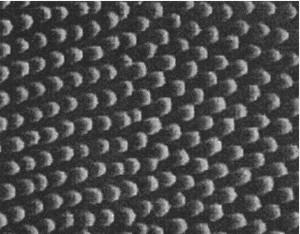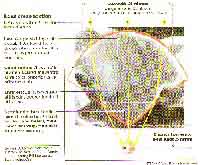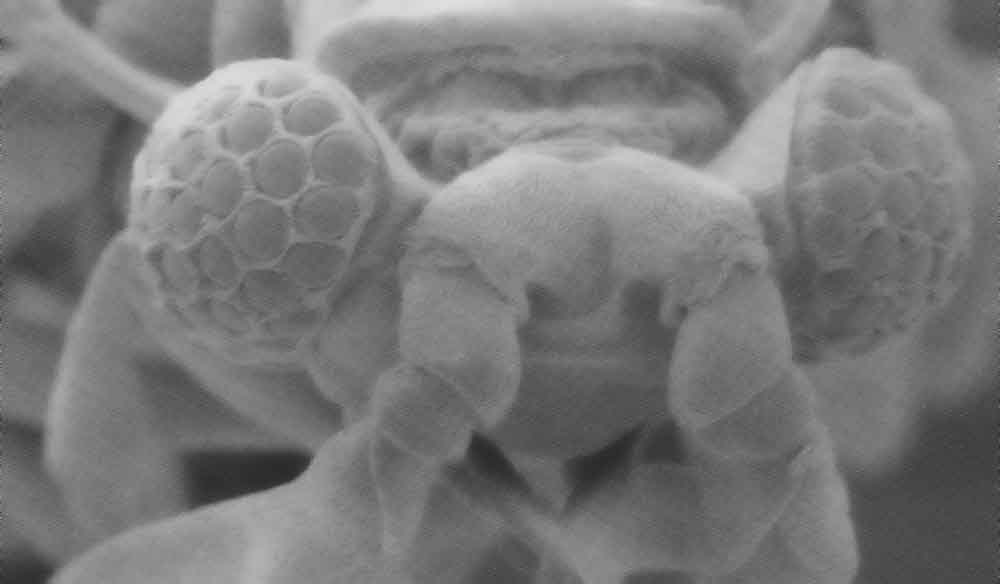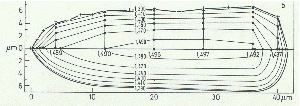(Click on underlined
link to go to subject)
Chapter 1. Vision System Design
Chapter 2.
Biological Eye
Designs
Chapter 3. Eye
Design Illustrations
Chapter 4. Eye
Reproduction
Chapter 5. Optical Systems Design
Chapter 6. The
Eye Designer
Related Links
Appendix A --
CRIS Speech & SlideShow by Curt Deckert
Appendix B - RAPID Speech by Curt Deckert
Appendix C - Comments From Our Readers
Appendix
D - Panicked Evolutionists: The Stephen Meyer Controversy
Chapter 6
Section C
(Click on PICTURE IN TEXT to bring up LARGE PICTURE)
6. THE EYE DESIGNER
C. Eye Designer Evidence
1. New discoveries
relative to vision
system design
Recently, some high technology companies have been able to duplicate the moths eye coating. It has taken considerable intelligent effort to understand the design and to develop a process to generate the very fine surface patterns.
Near the end of 2001, scientists have reported on some amazing eyes. A species of the brittlestar, related to Starfish, have an external skeleton made of crystals of calcite that make up a large distributed array of micro lenses that may give a composite image like that of a single eye. Behavioral studies of the extent of vision and the role of these eyes need to be completed to determine the extent of single image vision, the complexity of multiple images, and other roles of these optical sensors. These eyes are something like a digital camera that builds up an image pixel by pixel. Each pixel or small group of pixels has a small lens with a nerve ending at a focus point and a means of controlling the amount of light transmitted to the nerve ending.
Some people say that these creatures are very old, as much as 500 million years old. It took many years to make this eye discovery which has recently received considerable attention relative to providing new technology for the communications industry.
Why is it that we have to develop some new process, material, or technique before we find it in eyes?
We are opening up new layers of information as we develop new understanding. There is little probability that eye complexity and brain intelligence can exist without intelligent design. This is notably true of mans new artificial vision systems currently developed using considerable intelligence.
How can one place any significant probability on the origin of life apart from intelligent design, when up to ninety percent of present U. S. scientists seem to be shifting toward some variation of intelligent design?
There is an increasing number of scientists who believe that intelligence had to be involved in DNA programming within all cells. Although not all of these scientists believe in a specific Creator, there is still considerable intelligent design evidence in eyes that indicates we do have a specific Creator.
|
There is significance to
broad design themes. There are eight basic types of eye
system designs that represent most image-forming eyes in nature. This
seems to be evidence of a single designer/builder, because of the
commonality of vision design themes and variations within each of the
basic types of optical designs. (See the early part of
this section for a review of design types) according to size and
functions needed. The following diagram indicates visual processing
design of insects. By noting similar requirements in other creatures
one can start to see design themes that would tend to indicate an
intelligent intelligent Designer developed all vision systems. (Figure
6-18a from pg. 272, Philosophical Transactions of the Royal Society of
London, Vol. 337, 1992, What
Engineers Can learn from insect vision
By G. A. Horridge) Many agree that initial intelligence was required to produce complex eye cell development. Cells also have specific design themes and specific requirements much like incremental digital, rather than continuous analog, systems. These final cell increments indicate specific design rather than one evolving from another. There seems to be a crisp difference in design themes and in specific designs. This is true in distributed vision systems. For example, hemoglobin molecules in our blood light can sense well enough to regulate our body clocks. This is remarkable, in that it shows integration of light sensing in our total physical design beyond that previously assumed of eyes alone. (Figs 6.18b by permission of James T Fulton, Dir of Research Vision Concepts) |

Processing in Insect Vision. 
other processes in humans. |
The fact that many animals have been the same for thousands of years (without further "evolution") provides evidence that DNA codes work to produce accurate copies of the same eye design. Because of the variation of eyes, each type of creature sees the world in a slightly different way according to its abilities, needs, and roles. Each creature has a brain that understands images from slightly imperfect optical cells within eyes, to provide vision to allow them to survive and enjoy life. Potential for eye adaptability is designed into the DNA overall eye design to allow fine-tuning for new or changing environments.
Many insects and birds have variations in their color vision, which is necessary to find their kinds of food or to recognize their enemies. For example, birds have the need to detect dangerous snakes and other animals. By recognizing special color or design patterns and then reacting in different ways they avoid problems. Examples, such as the red marking on a black widow spider, are numerous. Eye research tells us that attention was given to the specific eye design of each animal to provide suitable vision for its specific role and survival. The Designer has taken special care in design of the eyes for each creature to provide clues for their survivability.
Do mutations do all of this?
3. Belief in a vision system designer
Why haven't insects grown larger and conquered the earth?
A master designer must have worked out the delicate initial ecological balance. That is a distinct possibility in the overall survival of life. Creative ecological design must have gone into achieving balance without the apparent need for human control. Human control has often upset this balance, but we are still surviving with less quality of life.
Small white flies with brains about the size of the period at the end of this sentence, have, of course, corresponding small eyes requiring considerable design. Some of these eyes make use of gradient index optical materials where the index of refraction varies according to a unique design that allows optical imaging without curved lenses. Many insect eyes are made up of a complex array of gradient index light pipes that act like lenses having a very specific design.
The complexity of very small insect eyes, such as those of the small white fly, indicates a creative designer able to integrate complex cell structure with image processing and optical sensing in a very small package. As these small eye designs are more completely understood, it will be possible for man to build smaller and more efficient artificial vision systems.
Each creature seems to have eyes that are specifically developed for it to carry out its role. This may be another reason why the probability of design by random evolution is so low. Even any probability is in question since a population has to be created out of something that does vary. Once we agree there is a designer, then we can talk about the probability of positive random evolutionary change and its relation to a framework of intelligent design.
Even though some adaptable design freedom seems to be designed into eyes, a definite Creation Beginning of the world limits the total time for any large-scale design evolution. One could even make a case for adaptability being a proof of intelligent design. There may be frustration by some scientists that the Creator of eyes is ahead of man in advanced eye technology. This may be an issue of pride that may enter into accepting evolution as a "safe" belief system. However, faith in evolution is not safe in the long term. It becomes evident from today's research that there must be a coordinated plan to control the vast number of variables in the world and in the total universe to allow life to continue. Many, such as the well-known astro-physicist, Dr. Hugh Ross, have studied the very low probability of the duplication of our earth.
Fundamental optical design concepts and scientific laws, identified by scientists, were discovered without the benefit of theories of evolution. For example, the second law of thermodynamics and many other scientific laws in the areas of physics and chemistry were discovered many years before theories of evolution were developed. Here, early scientists who had wisdom based on Biblical truth, made significant discoveries. Following 1850, the early theories of evolution caused some scientists to stray from their belief in the Creator. A majority of scientists, up to this time, had some appreciation and even a personal relationship with their Creator. Even today, there are highly significant scientists who believe in a Creator as evidenced by numerous scientific conferences and group meetings. This belief system includes a created universe and world that had a beginning. More currently, there have been Nobel Prize winners and many people in key scientific positions that are committed to their Creator.
nbsp; Even if we cannot resolve how vision or eye cells developed, how can we make any case for eye evolution into different designs? It would seem that intelligence is required for any significant advance in increased vision capability or a more compact design.
Because of the delicate environmental balance for each type of creature and its relation to the total world system, man has a key role in maintaining balance in the care of our earth. If we could not see, it would be difficult to have a significant role in the care of the world. Again, it is difficult to explain a working ecology management plan for the universe and how it is presently programmed for corrections without an intelligent Designer being involved. A key word is design, which infers intelligent input for creation of something. Perhaps there needs to be a joint effort, including engineers, scientists and theologians, to help understand vision design origins within a physics (or other scientific) framework.
Eyes are a key component of ones total vision system. As vision systems with intelligence play the key role in our care of the world, our Creator, the originator of all eyes, wants the key role in our lives. I believe, like many people, that there is only one true creator, God. This is evident by the creation around us, all we know about it, early Biblical writings, traditions, other historical writing, and the large number of followers who have given, or are willing to give, their lives over to God for His purpose. Over thousands of years of history this belief has cost many of them their lives. This is strong evidence, and it agrees with evidence of intelligent design, changed lives, and hundreds of Biblical predictions that have come true. Followers of Creator God, the master eye designer, have continued to survive every generation of scientists. These followers of God have truth, ethics, purpose, and hope for life beyond what most people presently experience.
Michael Behe describes the irreducible complexity evident in the microbiological machines that are present in even the simplest of eyes. Even a photosensitive spot that detects light is a very complex biological system. It appears simple only if we look at the gross macro appearance. That was really Darwin's major problem. He couldn't know the fine details that we know about today, so he assumed that the chemistry would be simple. Just plain protoplasm [much like Jello] was the common view of cellular materiels in the 19th and early 20th centuries. Microbiology and micro chemistry with detailed knowledge of cellular machines were unimaginable at that time, unless a person believed that our Creator was in the details, not with magic, but with marvelous technology. Check out Behe's article on Evidence for Intelligent Design from Biochemistry
Fundamental optical design concepts and scientific laws, identified by scientists, were discovered without the benefit of theories of evolution. For example, the second law of thermodynamics and many other scientific laws in the areas of physics and chemistry were discovered many years before theories of evolution were developed. Here, early scientists who had wisdom based on Biblical truth, made significant discoveries. Following 1850, the early theories of evolution caused some scientists to stray from their belief in the Creator. A majority of scientists, up to this time, had some appreciation and even a personal relationship with their Creator.
Even today, there are highly significant scientists who believe in a Creator as evidenced by numerous scientific conferences and group meetings. This belief system includes a created universe and world that had a beginning. More currently, there have been Nobel Prize winners and many people in key scientific positions that are committed to their Creator.
Download -- Irreducible Complexity Revisited by William A. Dembski -- William_Dembski@baylor.edu
Scientific and spiritual web sites are listed to further help answer your questions. We are interested in your comments and suggestions for future development of this site.
Click
for Links to
Other Web Sites on
Intelligent design





